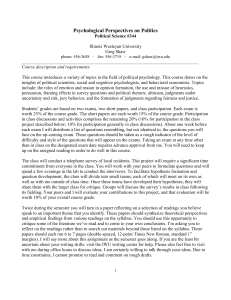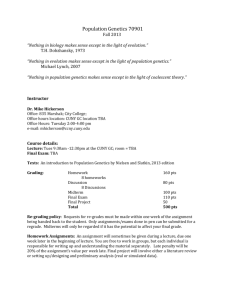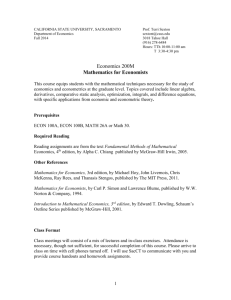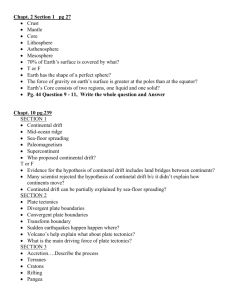BIOLOGY 3350 – Comparative Vertebrate Anatomy
advertisement
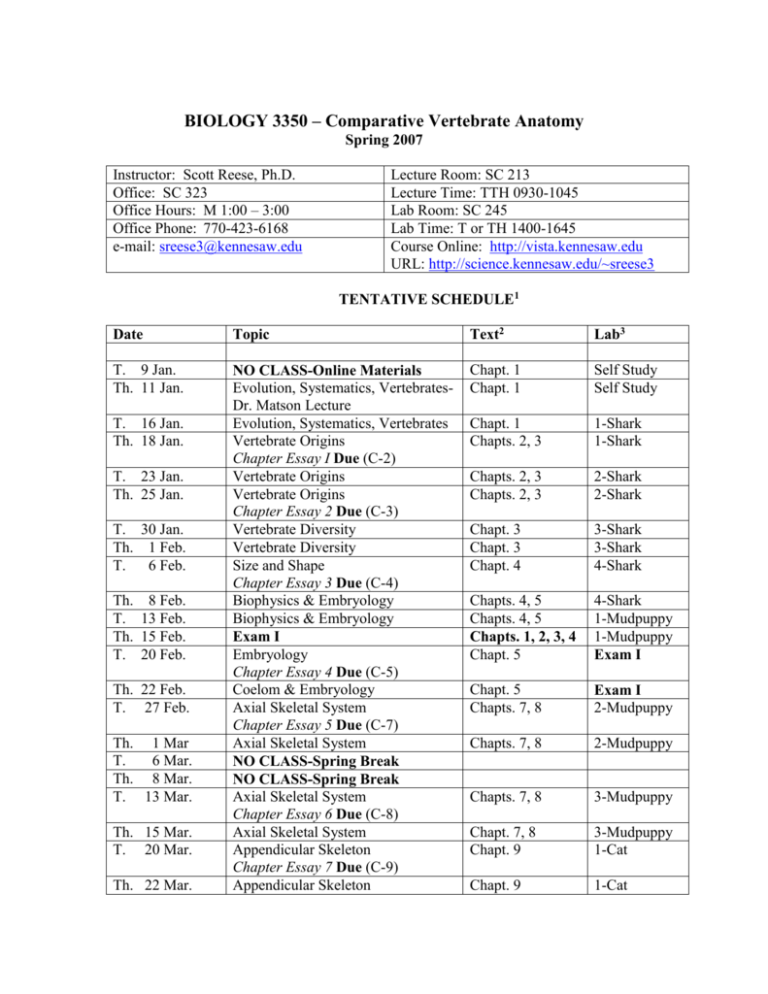
BIOLOGY 3350 – Comparative Vertebrate Anatomy Spring 2007 Instructor: Scott Reese, Ph.D. Office: SC 323 Office Hours: M 1:00 – 3:00 Office Phone: 770-423-6168 e-mail: sreese3@kennesaw.edu Lecture Room: SC 213 Lecture Time: TTH 0930-1045 Lab Room: SC 245 Lab Time: T or TH 1400-1645 Course Online: http://vista.kennesaw.edu URL: http://science.kennesaw.edu/~sreese3 TENTATIVE SCHEDULE1 Date Topic Text2 Lab3 T. 9 Jan. Th. 11 Jan. NO CLASS-Online Materials Evolution, Systematics, VertebratesDr. Matson Lecture Evolution, Systematics, Vertebrates Vertebrate Origins Chapter Essay I Due (C-2) Vertebrate Origins Vertebrate Origins Chapter Essay 2 Due (C-3) Vertebrate Diversity Vertebrate Diversity Size and Shape Chapter Essay 3 Due (C-4) Biophysics & Embryology Biophysics & Embryology Exam I Embryology Chapter Essay 4 Due (C-5) Coelom & Embryology Axial Skeletal System Chapter Essay 5 Due (C-7) Axial Skeletal System NO CLASS-Spring Break NO CLASS-Spring Break Axial Skeletal System Chapter Essay 6 Due (C-8) Axial Skeletal System Appendicular Skeleton Chapter Essay 7 Due (C-9) Appendicular Skeleton Chapt. 1 Chapt. 1 Self Study Self Study Chapt. 1 Chapts. 2, 3 1-Shark 1-Shark Chapts. 2, 3 Chapts. 2, 3 2-Shark 2-Shark Chapt. 3 Chapt. 3 Chapt. 4 3-Shark 3-Shark 4-Shark Chapts. 4, 5 Chapts. 4, 5 Chapts. 1, 2, 3, 4 Chapt. 5 4-Shark 1-Mudpuppy 1-Mudpuppy Exam I Chapt. 5 Chapts. 7, 8 Exam I 2-Mudpuppy Chapts. 7, 8 2-Mudpuppy Chapts. 7, 8 3-Mudpuppy Chapt. 7, 8 Chapt. 9 3-Mudpuppy 1-Cat Chapt. 9 1-Cat T. 16 Jan. Th. 18 Jan. T. 23 Jan. Th. 25 Jan. T. 30 Jan. Th. 1 Feb. T. 6 Feb. Th. T. Th. T. 8 Feb. 13 Feb. 15 Feb. 20 Feb. Th. 22 Feb. T. 27 Feb. Th. 1 Mar T. 6 Mar. Th. 8 Mar. T. 13 Mar. Th. 15 Mar. T. 20 Mar. Th. 22 Mar. T. Th. T. Th. 27 Mar. 29 Mar. 3 Apr. 5 Apr. T. 10 Apr. Th. 12 Apr. T. 17 Apr. Th. 19 Apr. T. 24 Apr. Th. 26 Apr. T. 1 May Appendicular Skeleton Exam II Respiration Respiration Chapter Essay 8 Due (C-11) Respiration Circulation Chapter Essay 9 Due (C-12) Circulation Circulation Digestion Chapter Essay 10 Due (C-13) Digestion FINAL EXAM Chapt. 9 Chapts. 5, 7, 8, 9, Chapt. 11 Chapt. 11 2-Cat 2-Cat 3-Cat 3-Cat Chapt. 11 Chapt. 12 4-Cat 4-Cat Chapt. 12 Chapt. 12 Chapt. 13 5-Cat 5-Cat Exam II Chapt. 13 09:30-11:30 Exam II 1 Please be aware that this schedule is tentative. Book: Kardong, K. V. 2002. Vertebrates: Comparative Anatomy, Function, Evolution. 4th Ed. McGraw-Hill, Boston, MA. 3Lab Manual: Fishbeck, D. W. & A. Sebastiani. 2001. Comparative Anatomy: Manual of Vertebrate Dissection. Morton Publishing. Englewood, CO. 2Text COURSE DESCRIPTION BIOL 3350. Comparative Vertebrate Anatomy. 3-3-4. Prerequisite: BIOL 2107, 2108. A survey of representative vertebrates and related chordates emphasizing phylogeny and anatomical adaptations. Evolutionary trends are examined in the context of large-scale environmental changes that have occurred over geological time. Lab component will have students dissecting selected vertebrate organisms and experimentally determining the physical forces acting on the evolution of vertebrates. COURSE PHILOSOPHY Comparative anatomy is an upper level course designed for biology and related majors. Prerequisites for this course are 10 quarter hours or 8 semester hours of majors level introductory biology. If you do not have these prerequisites, drop this course. Students without these prerequisites will be administratively withdrawn from the class. The major emphasis of lectures will be on the evolution of vertebrates (craniates) and the major changes that have taken place in the anatomy of vertebrates. The focus will be on certain key events that occurred in the evolution of vertebrates (e.g., evolution of vertebrates from proto-vertebrate ancestor; evolution of jaws; anatomical changes that occurred at the water to land transition). Within this evolutionary context, you will learn descriptive morphology (i.e., the names of structures) and functional anatomy (i.e., how the structures work). The major emphasis of labs will be on dissecting vertebrate organisms and learning anatomical structure. Key examples of anatomical transitions will be represented by a lamprey, a shark, an amphibian salamander (mudpuppy), and a cat. In addition, we will look at proto-chordates to view the early history of vertebrate evolution. The major push in lab will be the identification of anatomical structures that span many of the systems learned in lecture. This is one of the most important parts of comparative anatomy and represents a large fraction of your overall course grade. COURSE POLICIES Attendance and Participation: Class attendance and participation is highly encouraged and will be worth points. If you miss a lecture, it is your responsibility to obtain lecture notes from a classmate; my notes will not be made available to students. If you miss a lab, it is your responsibility to learn the material required. As part of the required materials for this course, you must purchase/obtain a personally identified, SRS remote for the Beyond Question system; they are available in the bookstore. During class I will be asking questions periodically and you will be required to use the remotes to answer the questions. If your remote is recorded as having answered all of the questions during a class period then you will be counted as present and participating for that lecture. If you fail to answer all the questions or do not attend, you will not be counted as attending or participating for that lecture. In lab there will be a sign-in sheet available no earlier that 4:30 PM; it is your responsibility to sign the sheet. Don’t come into class after 3 PM and expect to sign the sheet and don’t sign for your friends; either behavior will cause you to lose all of the points for participation. Please arrive before the beginning of lecture so as not to disturb your fellow students. You are encouraged to ask questions during lecture and lab. Turn off all cell phones, pagers, etc. Inclement weather: Its winter and should inclement weather arise such that the university closes (you can check the status of the university at this website, or by listening to WSB TV and radio), then these points will be adjusted accordingly. If the university does not close, then class will be held and these points will be tallied. Essays will not be excused for inclement weather and if the school closing is on an exam day, then please come prepared to take the exam on the next scheduled class time. Lab Preparation: You have 3 hours of lab time scheduled each week to dissect the animals and learn the anatomical structures. To make the most of this time, you need to come prepared, having looked at the material for a given day and done preparatory work before arriving. To encourage this behavior, there are pre-lab videos, powerpoints, and quizzes/assignments on WebCT that you need to complete before coming to lab. There are no make-ups for these class materials and completion of these materials will be a part of the grading scheme. Although you have 3 hours of scheduled lab time, if that is all the time you spend in the lab, you will find it exceedingly difficult to succeed in this course. As such, the lab is available for student access anytime that there is not another class scheduled Monday- Friday from ~8 AM till ~6-7 PM. The times are dependent on the presence of myself, Dale Zaborowski, and/or Letitia Saunders. There are no weekend times unless scheduled by me and the evening times are variable depending on weekly schedules. If you want access to the lab, there is no class in there, but it’s locked, please see one of the people listed who will unlock the door for you. Examinations: There are two lecture examinations scheduled during the semester along with a final exam. Each exam will be over the material covered in the lectures and readings since the last exam with emphasis being placed on the lectures. The final exam will be cumulative, although weighted heavily to new material. You must take all exams on the date offered. If you are unable to take the exam on the given date, you must have an acceptable reason (these need to be dire situations, not just your buddies party was the night before) and you must contact me before 9:30AM the day of the exam. An email is fine, though special effort should be made to speak to me directly. If I find your excuse acceptable (and you better have a good document trail), then your exam will be forfeited and whatever you achieve on the cumulative portion of the final will substitute for this score. Please be advised, you do not want to make the final weighted this heavy except in the direst of circumstances. If you miss an exam without an acceptable excuse, documentation, or without having contacted me before the proscribed time, you will receive the grade of 0 (zero) for that exam. You must take the final exam to receive credit for this course. There are two lab examinations scheduled during the semester. Each exam will be over the material covered up to that point, there is no cumulative final. If you receive 50% or less of the points on the first lecture or lab exam, please talk to me. Such a score indicates that you are having trouble in this class and you may need to consider withdrawing. Chapter Essays: There is a required essay for each chapter of the text. Each essay will be not more than 2-pages and will summarize the content of each chapter. They will be graded based on the scoring rubric that can be found on the course website. Each essay will be worth 20 points and I will only grade 5, selected at random from each person including the first one for everyone (there are a total of 10 essays). If you fail to turn in one of the essays I have chosen to grade at random, you will be given a score of 0 for that essay. I will not select a different essay to grade even if you turned in the other 9. There are no make-ups for the essays. You will utilize the plagiarism website or you will receive a score of 0 for the essay. All essays will be turned in via WebCT by the time that class starts on the due date in the schedule. Grades: The grading procedure for this course is as follows: Lecture Exam I 100 pts. (11 %) Lecture Exam II 100 pts. (11 %) Lecture Final Exam 150 pts. (17 %) Chapter Essays 100 pts. (11 %) Lab Exam I 200 pts. (22 %) Lab Exam II 200 pts. (22 %) Participation/Lab Preparation 50 pts. (6 %) Total 900 pts. (100 %) Your grade for this course will be based on the following point distribution: A 90-100 %; B 80-89 %; C 70-79 %; D 60-69 %; F < 60%. There is no “extra-credit." Dates and total points are subject to change if there are circumstances, deemed by me, to be extenuating. You will be given verbal notification of any changes in class or it will be posted on WebCT. The final grading scale may be adjusted at the discretion of the instructor and you will be informed via WebCT. Accommodations: Any student with a documented disability or medical condition needing academic accommodations of class-related activities or schedules must contact the instructor immediately. Written verification from the KSU disAbled Student Support Services is required. No requirements exist that accommodations be made prior to completion of this approved University documentation. All discussions will remain confidential. Academic Honesty: Every KSU student is responsible for upholding the provisions of the Student Code of Conduct, as published in the Undergraduate and Graduate Catalogs. Section II of the Student Code of Conduct addresses the University's policy on academic honesty, including provisions regarding plagiarism and cheating, unauthorized access to University materials, misrepresentation/falsification of University records or academic work, malicious removal, retention, or destruction of library materials, malicious/intentional misuse of computer facilities and/or services, and misuse of student identification cards. Incidents of alleged academic misconduct will be handled through the established procedures of the University Judiciary Program, which includes either an “informal” resolution by a faculty member, resulting in a grade adjustment, or a formal hearing procedure, which may subject a student to the Code of Conduct's minimum one semester suspension requirement. You are expected to follow the regulations as stated on pages 233-236 of the 2003-2004 of the Kennesaw State University Undergraduate Catalog. Plagiarism and cheating of any kind will not be tolerated. This includes copying papers and not providing proper literature citations. Any violations of the Student Conduct Regulations will be handled through the University Court. Withdrawal Policy: NEW ACADEMIC WITHDRAWAL POLICY EFFECTIVE FALL SEMESTER 2004 Students may withdraw from one or more courses anytime before the last three weeks of the semester. However, as of Fall 2004, students will be allowed a maximum of eight total withdrawals if they enter KSU as a freshman. Transfer students will be allowed one withdrawal per fifteen credit hours attempted, for a maximum of eight. Students who choose to pursue a second degree at KSU will be allowed two additional withdrawals. Students who entered KSU before the Fall of 2004 will be allowed one withdrawal per fifteen credit hours attempted for a maximum of eight. To withdraw, the student should complete an official withdrawal form in the Office of the Registrar. Students who officially withdraw from courses on or before the last day to withdraw without academic penalty will receive a “W”. Students who officially withdraw after the last day to withdraw without academic penalty (and before the last three weeks of the semester) will receive a “WF”, which will be counted as an “F” in calculation of their grade point average. The only exceptions to these withdrawal regulations will be for instances involving unusual circumstances, which are fully documented. Students may appeal to the academic standing committee for consideration of unusual circumstances. LAST DATE TO WITHDRAW WITHOUT ACADEMIC PENALTY Spring 2007 March 2, 2007 Recycling Policy: REDUCE WASTE AND RECYCLE. If possible, please use (purchase) recycled goods. On campus, paper can be recycled in the bins found in the front of each classroom and aluminum cans can be recycled in the appropriate containers in the hall. Please do not mix waste with the materials to be recycled. It's your planet, your campus, your health & well-being and your economy -- help them all by recycling. See page 248 of the current catalog for the KSU Position Statement on Environmental Awareness. URL: Copies of this syllabus can be found on the instructor’s Homepage. The URL is: http://science.kennesaw.edu/~sreese3/Comparative%20Anatomy.html Office Hours: My office hours are listed on the first page of this syllabus. I encourage you to avail yourself of them. If you cannot make it to any of these scheduled hours, please make an appointment. I'm certain that we can find a mutually acceptable time to meet. Your continued presence in this course signifies your acceptance of the policies and procedures outlined above.
